Related Research Articles

Theretra latreillii, the pale brown hawk moth, is a moth of the family Sphingidae described by William Sharp Macleay in 1826. It is found in most of Asia, including Borneo, China, Hong Kong, the Philippines, Taiwan and also in the tropical regions of Australia.

Theretra silhetensis, the brown-banded hunter hawkmoth, is a moth of the family Sphingidae described by Francis Walker in 1856. It lives in Indo-Australia, India, Sri Lanka, Papua New Guinea, East Australia, Solomon Islands, Fiji Islands, Vanuatu Islands.

Orsotriaena medus is a butterfly found in south Asia, southeast Asia, and Australia. It is the only species in the genus Orsotriaena, first described by Hans Daniel Johan Wallengren in 1858.
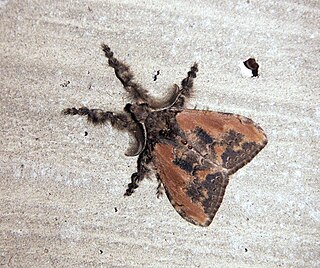
Olene mendosa, the brown tussock moth or hairy tussock moth, is a moth of the family Erebidae. The species was first described by Jacob Hübner in 1823. It is found in India, Bangladesh, Sri Lanka, Indonesia, Taiwan, Thailand and Australia.

Leuroperna sera is a moth of the family Plutellidae first described by Edward Meyrick in 1885. It is found in Japan, Taiwan, Vietnam, Indonesia, India, Sri Lanka, Australia, and New Zealand.

Carmara is a monotypic moth genus of the family Noctuidae. Its only species, Carmara subcervina, is found in Sri Lanka, Japan, Taiwan, Borneo and Australia. Both the genus and species were first described by Francis Walker in 1864.

Delgamma is a monotypic moth genus of the family Noctuidae erected by Frederic Moore in 1885. Its only species, Delgamma pangonia, the strawberry cutworm, was first described by Achille Guenée in 1852.
Oxygonitis is a monotypic moth genus of the family Noctuidae. Its single species, Oxygonitis sericeata, is found in the Indian subregion, Myanmar, Sumatra, Peninsular Malaysia, Java, Borneo, the Philippines, Sulawesi, Australia and Sri Lanka. Both the genus and species were first described by George Hampson in 1893.
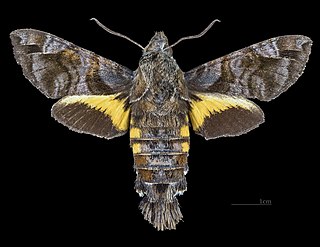
Macroglossum insipida, the hermit hummingbird hawkmoth, is a moth of the family Sphingidae. It was described by Arthur Gardiner Butler in 1875.
Hyperlopha cristifera is a moth of the family Noctuidae first described by Francis Walker in 1863. It is found in Sri Lanka, Laos, Malaysia and Australia. Adult wings are pale brown, sometimes with a number of dark dots near the tornus of each forewing. Forewings with a hooked wingtip, and a cusp on the margin can be found.
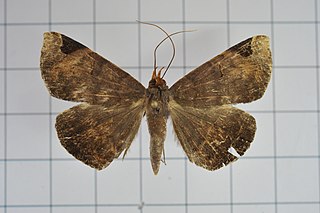
Mecodina praecipua is a moth of the family Noctuidae first described by Francis Walker in 1865.
Anomis figlina is a moth of the family Erebidae first described by Arthur Gardiner Butler in 1889. It is found in Sri Lanka, India, Australia and Japan.

Amblychia angeronaria is a moth of the family Geometridae first described by Achille Guenée in 1858. It is found in Sri Lanka, northern India, Korea, Andaman Islands to Taiwan, Borneo, Sumatra, Korea Japan and Australia.
Chorodna strixaria is a moth of the family Geometridae first described by Achille Guenée in 1858. It is found in India, Vietnam, Sulawesi, the Philippines, the Moluccas, New Guinea, Australia and Sri Lanka.

Traminda aventiaria, the cross-line wave moth, is a moth of the family Geometridae. The species was first described by Achille Guenée in 1858. It is found in the Indian subregion, Sri Lanka, to Hong Kong, Taiwan, New Guinea and Australia.
Leucania venalba is a moth of the family Noctuidae first described by Moore in 1867. It is found in Indo-Australian tropics of India, Sri Lanka, to Fiji and New Caledonia.
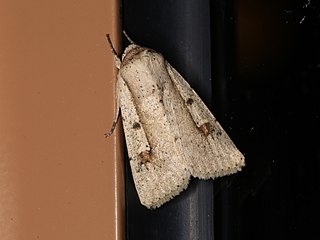
Leucania yu is a moth of the family Noctuidae first described by Achille Guenée in 1852. It is found in Oriental tropics of India, Sri Lanka, the Andaman Islands, Hong Kong, Indonesia, the Philippines, Taiwan east to Australia, Fiji and Tonga.
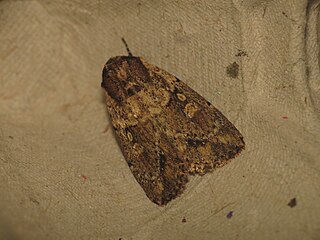
Mythimna reversa is a moth of the family Noctuidae first described by Moore in 1884. It is found in the Indian subregion, Sri Lanka, Borneo, the Philippines, Hong Kong, Malaysia and Australia.
Eublemma pudica is a moth of the family Erebidae first described by Snellen in 1880. It is found in Sri Lanka, India, Fiji and Australia.
Hypolamprus bastialis is a moth of the family Thyrididae first described by Francis Walker in 1859. It is found in India, Sri Lanka, Indonesia, New Guinea and Australia.
References
- ↑ "Oglasa Walker". The Moths of Borneo. Retrieved 2 March 2018.
- ↑ "Species Details: Oglasa captata Butler, 1889". Catalogue of Life. Retrieved 2 March 2018.
- ↑ Pitkin, Brian & Jenkins, Paul (5 November 2004). "Brevipecten Hampson, 1894". Butterflies and Moths of the World. Natural History Museum, London. Retrieved 4 October 2018.
- ↑ Koçak, Ahmet Ömer; Kemal, Muhabbet (20 February 2012). "Preliminary list of the Lepidoptera of Sri Lanka". Cesa News. Centre for Entomological Studies Ankara (79): 1–57. Retrieved 2 March 2018.
- ↑ Herbison-Evans, Don & Crossley, Stella (23 August 2012). "Brevipecten captata (Butler, 1889)". Australian Caterpillars and their Butterflies and Moths. Retrieved 4 October 2018.
| This Calpinae article is a stub. You can help Wikipedia by expanding it. |